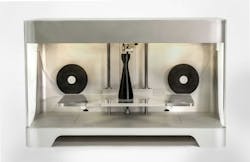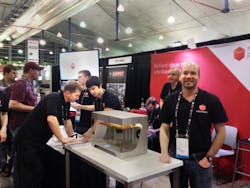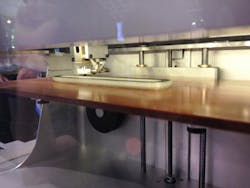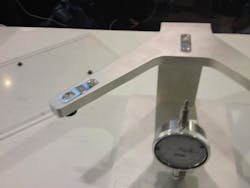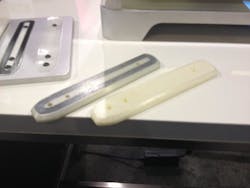MarkForged: $5,000 3D printer prints carbon-fiber parts
Start-up company MarkForged is now selling $5,000 3D printers that print carbon-fiber parts. Called Mark One printers, the machines will start shipping later in 2014.
The Mark One printers — roughly 13 x 14 x 22 in. to make parts to 6.25 x 6.25 x 12 in. — are the first in the world to 3D print carbon-fiber parts. That pairs the unbound potential of 3D printing with the advantages of high-strength material — through a process MarkForged calls Composite Filament Fabrication (CFF). Parts made with CFF are printed in a thermoplastic matrix of layers that incorporate continuous strands of reinforcing fibers. The long strands carry loads down the entire part, for a stronger part overall.
More specifically, CFF-built parts are up to 20 times stiffer than ABS plastic, five times stronger, and have a higher strength-to-weight ratio than 6061-T6 aluminum. That lets designers to 3D print functional parts that would otherwise need to be CNC machined.
"We removed the strength limitations of 3D-printed plastic parts," says Greg Mark, founder and CEO of MarkForged. He also says that the printer is made to be user-friendly like most other desktop 3D printers.
MarkForged made its first big entry into the industry at SolidWorks World this January in San Diego. Here's the company's Greg Mark (in the black shirt) onstage at one of the SolidWorks World General Sessions, explaining his machine's technology to an enthralled crowd:
In fact, the night before the big appearance, I wandered past MarkForged's booth in the SolidWorks Partners Hall, a trade show-like venue for companies that sell products complementary to the software.
Over the course of a couple more hours, the MarkForged booth attracted a steady stream of curious attendees:
At the event, I chatted with Greg Mark, who went out of his way to lure people over.
Mark is an MIT aerospace engineer who originally worked at Aeromotions designing and manufacturing high-performance composite racecar wings. But Mark wanted to use 3D-printing hardware to automate the composite layup process, so left and assembled a team of MIT engineers to develop a machine for the job. In fact, a couple MarkForged engineers at the booth mentioned to me how the guidance of Alexander Slocum, Neil and Jane Pappalardo Professor of Mechanical Engineering at MIT, was instrumental in the creation of MarkForged.
Here are some of the printer's parts Mark and the rest of the team showed me:
The printer also supports traditional 3D printing (FFF) with nylon and PLA plastic.
At the end of my booth tour, I got to see two finished products — a couple samples of what the Mark One can make.
The team's samples include one part with a nylon base (for a tough outer shell) sandwiching layers of carbon fiber that impart strength. (This particular sample has 3 x 200 µm layers of carbon fiber on the top and bottom for six layers in all.) To allow for a bit of comparision, Mark then invited me to flex an all-nylon part of the same geometry — a part that proved (surprise, surprise) far less rigid than the reinforced one.
Drop us a line below and tell us how you think you'd make use of a Mark One.
About the Author
Elisabeth Eitel
Elisabeth Eitel was a Senior Editor at Machine Design magazine until 2014. She has a B.S. in Mechanical Engineering from Fenn College at Cleveland State University.
